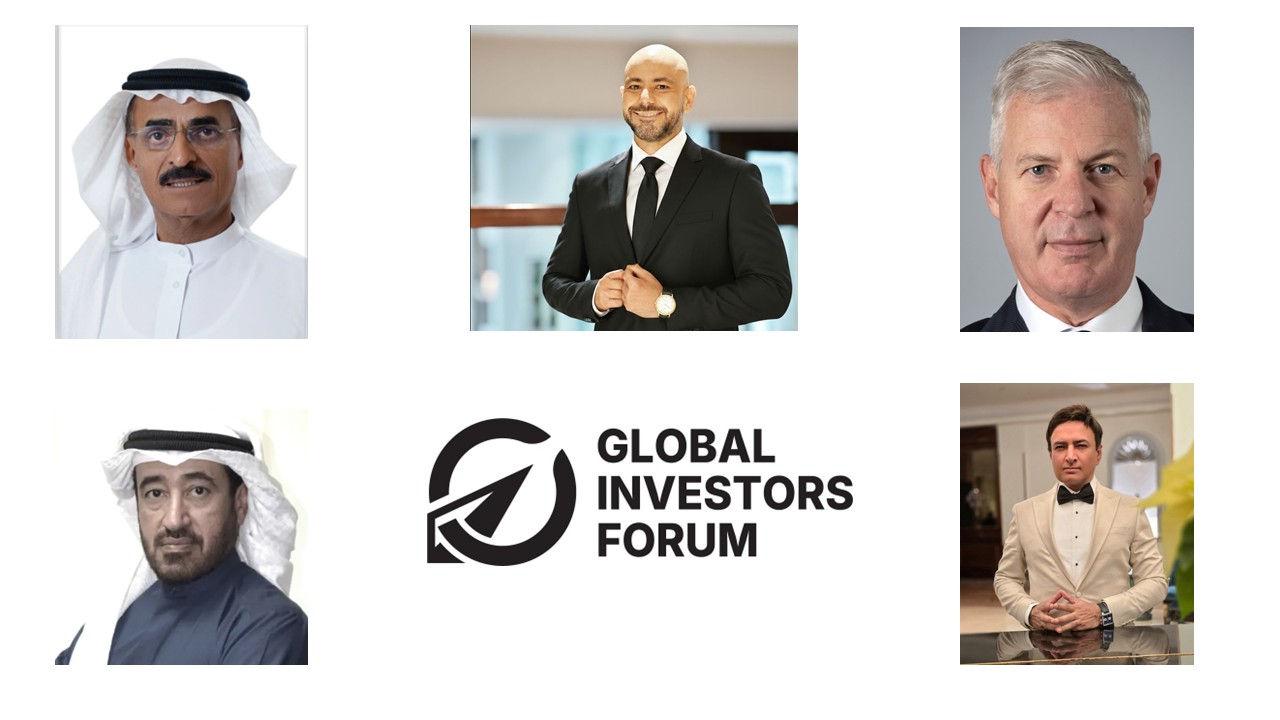Financial
Optimism, Growth, and Transformation for the Financial World in 2025!

By- Dr. Jelena Janjusevic, Associate Professor in Finance at Heriot-Watt University Dubai
The financial environment is evolving at an unprecedented pace, driven by significant demand for technological change, increasing demands for sustainability, and shifting regulatory frameworks. Various developments are bound to emerge over time, which are likely to change how financial entities operate, invest, and interact with clients. These changes will determine the future and create possibilities for further business growth.
Transforming financial services with AI
AI is greatly impacting the finance sector, enhancing the strategic aspect and improving business processes in general. Everything from predictive analytics to AI-powered friction prevention systems encompasses potential. Robo-advisory, which dispenses customized investment strategies at scale, is also gaining popularity among individual and institutional investors. However, the rapid use of AI poses some issues regarding ethics and accountability. To ensure that the use of AI is accompanied by the best standards and practices, regulators come into the picture ensuring that compliance is one of the major concerns for financial institutions.
Sustainability in finance becomes a trend.
Sustainable finance is no longer a novel approach but a basic business standard. The market for green bonds and sustainability-linked loans is growing, driven by corporate commitments to net-zero goals and investor demand for ESG-compliant portfolios. Governments are introducing regulations to enhance transparency in ESG reporting, while fintech innovations are making it easier to track and assess sustainability metrics. This trend represents an opportunity for financial leaders to align their portfolios with long-term environmental goals, catering to socially conscious investors and improving their own operational resilience.
Central Bank digital Currencies (CBDCs): a game changer
The very idea of Central Bank Digital Currencies (CBDCs) is gradually becoming feasible, as several nations, particularly China, UAE and the European Union, are testing these digital currencies. The sheer scope and scale of CORD will mean a transformation of the interface to transfer and cross-border payments, along with cost reduction and a potential increase in the number of those included in the financial economy. Despite their potential, challenges remain, such as data privacy, and how these currencies will operate in relation to commercial banks. The evolution of these dynamics is what the financial world is watching with great interest.
Cybersecurity becomes the focus
The necessity to protect financial assets becomes the center of focus because the risks of cyber attack have increased multifold as the financial entities have started rolling out more of web based applications and solutions. In 2025, cyber security would be the demand priority, as companies expect multi-factor authentication, advanced encryption, and zero-trust frameworks to rank among their top priorities.
In combating these challenges and providing the reliable ecosystem that restores consumer confidence and protects sensitive customer information, cooperation between regulators, governments and financial entities will play a significant role.
Hyper-personalisation in financial services
Today’s consumers are looking for financial products that fit their tastes, objectives and their individual situations. The concept of hyper-personalization has quickly developed into a dominant paradigm and an important competitive differentiator throughout the financial sector through exploiting the benefits of advanced data science and artificial intelligence technologies. This approach allows institutions to evolve from basic products and services towards complex ones, including bespoke deposit accounts, specific investment tools and personal investment consultants. The service providers of financial markets adopting customer-oriented innovations not only improve customer retention and loyalty but also enhance their prospects in the marketplace that is becoming more and more personal and technologically oriented. Companies that accept this transition will excel in this new age where targeting and understanding an individual’s needs will matter the most.
Regulatory shifts and their impact
As the financial sector evolves, more regulations concerning cryptocurrency, ESG disclosure and data privacy are being introduced to help manage the risks. In the actions at the international stage, the EU’s MiCA concerning crypto assets, international standards on ESG reporting, and more stringent legislation on data privacy, such as GDPR, affect the industry. Responding to these changes in laws is a challenge that calls for rethinking the organistion’s strategy. Financial institutions must develop systems, invest in compliance structures, and practice follow-up of regulatory changes. They must also encourage integrity and officer accountability.
The changing regulations, on the other hand, can be seen as hindrances or enhancements to the global financial market. Those institutions that effectively manoeuvre the changes brought about by these regulations will be able to do well in the increased times with increased focus and standards. Financial institutions that make investments in compliance systems and increase transparency by availing all information will reduce risks, gain market trust and emerge as key players in the dynamic regulatory environment.
The influence of Gen Z and Millennials
New generations are currently changing the game when it comes to money as they opt for a digital-first approach and prefer to invest in sustainable options. Products such as Buy Now, Pay Later (BNPL) and micro-investing platforms target them directly. As pointed out, these potent demographics require constant innovation on the part of financial institutions, ensuring that services provided are convenient and user-oriented as well as demand-driven.
Challenging processes like adopting AI, being more environmentally conscious and readying up for the rise of blockchain technologies and financial regulators would not be as easy as it sounds. However, the year has a bright side as well, as it gives ample opportunities for financial leaders. Prioritising these trends would allow any financial organisation to be seen in the eyes of their customers as trustworthy and reliable without any complications that would lead to long-term stability and growth.
As we approach 2025, one thing is certain: the future of the financial industry is set to change significantly. Financial institutions that act decisively and strategically in adapting to these regulatory shifts will not only mitigate risks but also position themselves to thrive in this dynamic and evolving environment.
Financial
Global Investors Forum 2025: A Strategic Platform Connecting the GCC with Eurasia Through a Unified Investment Ecosystem

Georgia’s capital Tbilisi is gearing up to host the Global Investors Forum (GIF 2025), one of the world’s leading economic platforms designed to strengthen cooperation between GCC countries and Eurasia through a unified investment ecosystem that accelerates growth, deepens economic ties, and expands cross-border investment opportunities.
GIF 2025 is organised in strategic partnership with EurAsia Gulf and the International Chamber of Commerce in Georgia (ICC Georgia), with AGI Holding serving as the main partner. The forum is also supported by the International Chamber of Commerce (ICC) and, Embassy of Georgia to the UAE, and the Hong Kong–Middle East Business Chamber.
The forum, a premier investment platform, is a major international gathering that connects global capital with promising investment opportunities across the world. Through a unified investment ecosystem, GIF brings together governments, investors, and international economic institutions under a shared vision of collaboration and sustainable growth.
The two-day event will include panel discussions, investment showcases, and high-level business matchmaking sessions, bringing together more than 1,500 participants, 70 institutional investors, and 50 international speakers from over 40 countries. Taking place from 4 to 5 December 2025, GIF 2025 will focus on five key sectors: sustainability and technology, tourism, digital assets and securitisation, real estate and infrastructure, agricultural technology (Agri-tech) and food security.
The forum, marking a major economic turning point for Georgia and the wider region, will witness the launch of strategic partnerships and the signing of major international Memoranda of Understanding between government and private investment institutions from various Arab and foreign countries, including the GCC countries. These agreements aim to create cross-border financing and cooperation channels in vital sectors such as clean energy, sustainable technologies, medical tourism, smart infrastructure, and digital agriculture as key areas for investment.
The event will feature high-profile participation from leading international economic figures, including H.E. Dr Abdullah Belhaif Al Nuaimi, Chairman of the Sharjah Consultative Council (UAE); H.E. Hamid Mohammed bin Salem, Secretary-General of the Federation of Chambers of Commerce and Industry (FCCI UAE); With the attendance of H.E Aisha Mohammed Saeed Al Mulla, Chairwoman of the UAE Businesswomen Council, along with a delegation from the Council; Dr Taysir Al Khunaizi, Partner and Deputy CEO of the Georgia Saudi Investment Corporation; and Dr Sadeddine Mneimne, Chairman of AGI Holding and Founder of the Global Investors Forum.
Also taking part are a distinguished group of global leaders, among them Aref bin Ali Al Abbar, President of the Hobbies Club in the United Arab Emirates, and Arif Anis, internationally recognised leadership expert and recipient of the Member of the Order of the British Empire (MBE); John W.H. Denton, Secretary-General of the International Chamber of Commerce; Chamas Awad, Founder and CEO of Euro Gulf Consulting and adviser to the Belgian Royal Family; and Hani Idris, Board Member of the International Development Bank (IDB).
They will be joined by senior investors, ministers, and heads of major economic institutions, sovereign wealth funds and multinational corporations, as well as delegations from more than 40 countries, all convening under the theme: “Bridges Between Continents – From the GCC to Eurasia: Investing in the Future of Global Prosperity.”
Speaking on the occasion, His Excellency Dr Abdullah Belhaif Al Nuaimi, Chairman of the Sharjah Consultative Council – UAE, said: “The links between investment and sustainability are growing stronger amid rising global risks such as climate change, and resource depletion. By integrating environmental, social, and governance (ESG) standards, investors are seeking to reduce their exposure to volatile assets and strengthen long-term resilience. Green technologies, renewable energy, and nature-positive infrastructure have become increasingly attractive areas for capital, while AI-driven tools now support climate scenario modelling and help optimise investment portfolios. Sustainability is no longer merely an ethical choice; it has become a financial strategy for navigating environmental uncertainty.”
He added that the international forum aligns with the needs of the future, bringing together investors, decision-makers, policymakers, and academics under one roof to demonstrate the world’s ability to adapt and navigate all these mounting challenges.
Dr Sadeddine Mneimne, Founder of the Global Investors Forum and Chairman of AGI Holding, said: “The Global Investors Forum is not just a conference, it is a strategic economic platform reshaping the map of global cooperation by connecting the GCC with Eurasia through a unified framework for investment and partnership.” He underscored as saying as: “The upcoming edition of the forum in Tbilisi will mark a pivotal turning point in strengthening economic integration between East and West. It will catalyse a new wave of cross-border investments and open unprecedented opportunities for global capital. The forum aims to foster long-term partnerships between governments, international institutions, and the private sector, reinforcing global economic cooperation and redefining the investment landscape across the region.”
Arif Anis, recipient of the Member of the Order of the British Empire (MBE), said: “It is a great honour to participate as a keynote speaker at the Global Investors Forum 2025, at a time when global capital is experiencing significant turbulence, with foreign direct investment slowing and funding for vital projects declining by 26%. This is precisely why Dr Sadeddine Mneimne’s vision stands out as exceptional, he is not simply organising a conference but boldly confronting an unsettled economic reality with clarity and bravery.
He added: “The GIF will explore the future of global finance, as 130 countries move towards digital currencies, alongside the accelerating artificial intelligence revolution, which has attracted 37% of global investment capital. The forum will bring together more than 1,000 industry leaders at precisely the right time and in the right place, to launch through the major conversations that will shape the decade ahead.”
John W.H. Denton, Secretary-General of the International Chamber of Commerce, said: “In a time of uncertainty and disruption, the private sector has a critical role to play in driving the investments that help economies and communities thrive. As the voice of business representing over 45 million companies across 170 countries, our mission to make business work for everyone, every day, everywhere has never been more urgent.”
The forum represents a significant step forward in advancing international cooperation between emerging markets and global investors. By hosting GIF 2025, Georgia aims to reinforce the importance of economic collaboration in connecting the Middle East with Europe and Central Asia. UAE-Georgia economic relations have been experiencing rapid growth, with both countries enjoying increasing trade and investment flows in recent years, supported by major investment agreements exceeding USD 6 billion in development and infrastructure projects. Recent data shows that the UAE now accounts for more than 63 percent of Georgia’s total trade with Arab countries, while its investments in Georgia represent 5 percent of its total foreign trade investment (FDI), placing the UAE as Georgia’s sixth-largest global investor.
GIF 2025 is expected to yield a series of major investment agreements valued at hundreds of millions of dollars, with a strong emphasis on advancing green projects and financing innovation in renewable energy and digital infrastructure. These anticipated outcomes will further solidify the UAE’s position as a global economic hub connecting GCC markets with Europe and Asia and strengthen its influential presence within the new global economic landscape.
Financial
Bridging Global Finance and Regional Demand in the UAE

With a strategic foothold in the UAE, global financial players are tailoring platforms, Sharia-compliant solutions, and tech-driven experiences to meet the region’s evolving trading demands.
Here is an exclusive interview with Pavel Spirin, Chief Growth Officer, Rostro Group.
Scope Markets is planning to expand into the UAE. What strategic importance does this region hold for your global operations?
The UAE plays a key role in our global strategy. While the population may be relatively small at around 10 million, the country is a gateway into the wider MENA region, where we see strong and growing demand for financial services. We’ve already received provisional approval from the Securities and Commodities Authority and are in the final stages of securing our full license. This market allows us to bring decision-making closer to our regional clients and establish a meaningful presence in a fast-growing financial hub.
How is Scope Markets differentiating itself in the highly competitive UAE financial services and trading space?
We’re focused on building products and experiences that genuinely reflect what clients here want. That means offering Sharia-compliant and swap-free account options, streamlining transactions to ensure instant deposits and withdrawals, and optimizing our platforms for mobile use. We’re also committed to being fully licensed and regulated in the UAE, which we believe is essential for building trust. Ultimately, our goal is to provide a responsive and tech-forward experience tailored to the unique needs of traders in this region.
What has been your experience working within the UAE’s regulatory frameworks, and how do you view the country’s role as a global financial hub?
Our experience with the Securities and Commodities Authority has been very constructive. The regulatory process is clear and well-structured, which gives firms like ours confidence in long-term planning. We’re currently finalizing our licensing and taking the required regulatory exams. What stands out to us is how fast the UAE has developed its financial infrastructure. It’s building frameworks for crypto, fintech, and online trading at a pace we haven’t seen elsewhere, and that positions the country as an increasingly important global financial center.
How are you tailoring your offerings, platforms, or services to better serve traders and investors in the UAE and the wider GCC region?
We’re building out our product range and services to reflect the regional demand for asset classes like gold, along with culturally aligned features such as Sharia-compliant accounts. We’ve also seen that mobile-first experiences, fast execution, and automation are priorities for traders here, so those are central to our platform development. On the service side, we’re looking to establish regional support functions to make sure our clients in the UAE and GCC are well served and engaged.
What major trends do you see shaping the future of online trading and fintech in the Middle East, and how is Scope Markets positioned to respond to them?
We’re seeing rapid growth in mobile-first fintech adoption, a strong push for automation, and increased regulatory clarity in areas like crypto. Traders are becoming more sophisticated and expect seamless user experiences, fast payments, and localized features. There’s also strong interest in diversification, particularly in gold, which continues to attract attention due to global uncertainty. We’re positioning ourselves to meet these needs through tech development, regulatory compliance, and regional product adaptation so we can evolve with the market.
What message would you like to share with your UAE-based clients and stakeholders about Scope Markets’ long-term plans in this market?
We’re here for the long term. We’re committed to being fully licensed, transparent, and responsive to the needs of traders in the UAE. This includes delivering regionally relevant products, building local infrastructure, and continuing to invest in the tools and technology that matter to our clients. Our aim is to support traders with a platform that’s reliable, compliant, and built around how people in this market want to trade.
Financial
Emerging Trends Shaping Financial Empowerment and Inclusion in the UAE Workforce

By Claudio Di Zanni, Managing Director, Edenred Middle East

One of the most critical issues faced by low-income employees across the UAE and the broader Gulf region is achieving true financial empowerment. In the UAE, over 60% of the workforce comprises low-income migrant workers earning less than AED 5,000 per month. These employees are the backbone of the nation’s key industries, yet many still struggle to access the benefits of a fully digital financial ecosystem.
While the UAE’s Wage Protection System (WPS) was introduced to safeguard workers’ rights—ensuring salaries are paid accurately, on time, and through traceable digital channels—the banking system’s minimum salary requirement prevents a large portion of the workforce from opening traditional accounts. This creates a structural gap that payroll solutions are designed to fill, enabling compliant salary payments and basic access to digital finance.
As the Middle East accelerates its digital transformation and workforce reforms, how workers are paid and supported financially has become as important as how they contribute to growth. This shift has put a renewed spotlight on the systems managing their wages and day-to-day financial needs. For low-income employees, these systems determine not just how they are paid, but how securely they live—affecting access to savings, remittances, and their ability to handle emergencies.
When Digital Pay Isn’t Enough
The introduction of the Wage Protection System marked a turning point in the UAE’s journey toward fair and transparent wage practices. Today, nearly all employees are paid through digital channels, ensuring salaries are disbursed accurately and on time. Yet despite these advances, a significant percentage of wages are still withdrawn in cash each month, showing that digital pay does not automatically translate into digital financial inclusion.
For many employees, limited digital literacy, mistrust of financial systems, and unfamiliarity with digital tools prevent them from engaging fully with the digital economy. As a result, the very system designed to protect and empower workers can feel more like a compliance obligation than an opportunity for empowerment.
This is where payroll providers play a critical role. Too often, the industry stops at compliance—ensuring wages are delivered digitally—without addressing the human factors that determine whether employees can truly benefit from financial technology. Empowerment comes not from the transfer itself, but from helping workers understand, trust, and use digital money confidently. Only then can payroll innovation translate into lasting financial well-being and equal access to economic opportunity across the UAE.
Digital salary management platforms have already transformed how employees receive and manage their earnings. Mobile apps and prepaid cards now give workers immediate access to their wages, allowing them to make purchases, send remittances, and track expenses in real time. Many solutions integrate seamlessly with the WPS, enabling even unbanked employees to participate in the digital economy for the first time. A recent study found that organizations implementing mobile-accessible payroll solutions report up to 25 percent higher employee satisfaction, underscoring the clear business value of digital inclusion.
Empowering Through Education
Financial literacy programs are equally critical in helping employees make informed decisions about saving, budgeting, credit, and long-term planning. In the UAE, less than 31 percent of the population demonstrates basic financial literacy, highlighting a major opportunity to empower workers through education.
From workshops to mobile-based learning tools, such programs can equip employees with the practical skills to use digital salary systems effectively, avoid debt traps, and build savings or plan remittances. Employers that distribute salary cards directly at worker accommodations and provide multilingual support during onboarding see much higher adoption rates, as these field-level activations build trust and make digital tools easier to use.
Employers who take financial education seriously often see a clear business impact. Companies that invest in onboarding sessions and field engagement consistently report higher digital adoption rates. These activations not only build trust but also transform digital payroll from a compliance task into a tangible employee benefit.
When workers understand and trust digital tools, they gain control over their finances—and that stability shows at work. Financial stress is one of the most common challenges among low-income employees, limiting their ability to manage urgent expenses and affecting productivity, retention, and overall well-being. In sectors such as construction, this stress can even impact concentration and safety, as employees distracted by financial worries are less able to perform at their best.
Partnerships between employers and fintechs like Edenred are expanding this approach, combining digital wage tools with financial education programs that improve confidence, satisfaction, and long-term well-being.
The Next Phase of Financial Empowerment
Employers remain central to driving inclusion. By choosing payroll partners that provide multilingual support, education, and easy mobile access, companies can reduce disputes, strengthen retention, and improve overall workforce stability.
A growing number of organizations are now exploring earned wage access programs, which allow employees to access a portion of their earned income before payday. Surveys show that most low-income workers value this flexibility to cover urgent expenses, medical bills, or family emergencies—without resorting to high-interest loans or informal borrowing. When paired with education and budgeting tools, earned wage access can provide not just relief in emergencies but also encourage more responsible money management.
This flexibility can increase employees’ sense of financial security, yet it should complement—not replace—broader financial literacy and planning initiatives. The most successful models combine accessible financial products, user education, and ongoing engagement, ensuring workers have both the tools and the confidence to manage their finances effectively.
As technology evolves, artificial intelligence and data analytics will make financial support more personalized and accessible. Predictive models can help employers identify employees under financial strain, while new digital products can guide users toward healthier financial behaviors. But technology alone will not close the gap.
Real progress will depend on collaboration between fintechs, employers, and regulators to build an ecosystem that blends technology, education, and empathy. Businesses increasingly recognize that supporting workers in their financial journeys fosters a more engaged and loyal workforce, directly impacting productivity and retention. Selecting payroll partners that combine compliance with education, multilingual support, and mobile accessibility helps companies reduce payroll disputes and improve satisfaction.
The trajectory of financial empowerment for low-income employees in the UAE is promising. The next stage will depend on how effectively stakeholders align innovation with understanding—ensuring every salary payment becomes an opportunity for inclusion and growth. When that happens, financial empowerment will move from aspiration to reality.
-

 Tech News1 year ago
Tech News1 year agoDenodo Bolsters Executive Team by Hiring Christophe Culine as its Chief Revenue Officer
-

 VAR7 months ago
VAR7 months agoMicrosoft Launches New Surface Copilot+ PCs for Business
-

 Tech Interviews2 years ago
Tech Interviews2 years agoNavigating the Cybersecurity Landscape in Hybrid Work Environments
-

 Tech News4 months ago
Tech News4 months agoNothing Launches flagship Nothing Phone (3) and Headphone (1) in theme with the Iconic Museum of the Future in Dubai
-

 Tech News2 years ago
Tech News2 years agoBrighton College Abu Dhabi and Brighton College Al Ain Donate 954 IT Devices in Support of ‘Donate Your Own Device’ Campaign
-

 Editorial12 months ago
Editorial12 months agoCelebrating UAE National Day: A Legacy of Leadership and Technological Innovation
-

 VAR1 year ago
VAR1 year agoSamsung Galaxy Z Fold6 vs Google Pixel 9 Pro Fold: Clash Of The Folding Phenoms
-

 Cover Story9 months ago
Cover Story9 months agoUnifonic Leading the Future of AI-Driven Customer Engagement






















